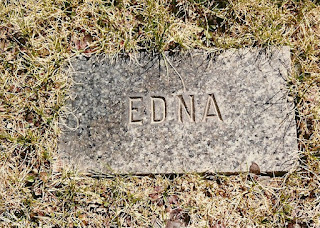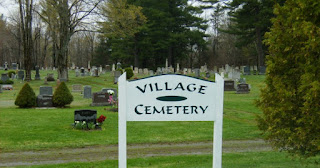For the past several years I have been wotking with the Gardiner, Maine Library to document Oak Grove Cemetery. It the largest cemetery in the city, but the only documentation of the cemetery was from the 1940s when the WPA sent people around to collect data on any American War Veterans buried within each town. MOCA (Maine Old Cemetery Association never documented the cemetery). Sadly many mistakes were made by the WPA. Gravestones that had the title "Captain" were often credited as military titles and not sea captains. Also if cemetery lot contained a known veteran's burial, the name of the person on the gravestone was listed as the veteran. This was a case in Gardner were a Civil War soldier was recorded buried in a lot, but the gravestone on the lot was for his son and daughter-in-law. The soldier's son was listed as the Civil War soldier and would have been four years old when he enlisted. However, military records matched the father's service and no record of the 4 year old was ever found serving in the war.
It reminded me of the cemetery lot of my great-grandparents in Exeter, Maine. The Skinner family lot in Chamberlain Cemetery has 5 gravestones and 1 metal marker on the lot and yet there are more than 8 people in the family lot.
Who is actually in the Cemetery Lot?
1. Andrew Jackson Skinner born 23 March 1828 in Raymond, Maine, son of Peter and Sally (Meserve) Skinner. Andrew served as a Corporal in Company K, 22nd regiment of the Maine Infantry during the Civil War. He died 23 August 1910 in Exeter, Maine of heart disease. Andrew and his son, Myron purchased the lot in 1903 after Myron's wife's death. He was the 3rd person to be buried in the lot.
2. Mary Elizabeth (Brown) Skinner, wife of Andrew Skinner and daughter of James and Sarah (Robinson) Brown. She was born on 30 September 1834 in Exeter, Maine. She married Andrew Skinner on 30 April 1855 in Bradford, Maine. She had two sons, George and Myron. She died on 15 August 1907 in Exeter, Maine of breast cancer. Her parents are also buried near by in this cemetery. She was the 2nd person to be buried in the lot.
3. Myron Leslie Skinner, son of Andrew and Mary (Brown) Skinner. He was born 23 May 1868 in Raymond, Maine. He purchased the lot with his father after his wife's death on 1903. Myron died on 23 November 1951 in Dexter, Maine. He was a saleman in Portland, Maine and then a farmer in Exeter. He was known to be reclusive later in his life, leading to rumors about him as many did not know he had been married and had 4 daughters who grew up adoring their "Papa." He was the 5th person to be buried in the Skinner lot.
4. Edna Estelle [Southard] (Pease) Skinner, daughter of Omar and Georgetta (Moore) Southard, was born on 26 April 1872 in Corinna, Maine. She was adopted by John and Christina (Tibbetts) Pease of Exeter, Maine. John Pease lived next door Andrew Skinner and served in the same Civil War Comapny as Andrew. Edna married Myron Skinner on 14 March 1891 in Corinna, Maine. They had four daughters and her husband moved the family to Portland, Maine in 1893. Edna died on 30 April 1903 in Portland, Maine from blood poisoning after the birth of her 4th daughter. Edna was the first person to be buried in the lot. Her adopted parents have the adjoinung lot.
5. George Washington Skinner, son of Andrew and Mary (Brown) Skinner, was born on 4 May 1857 in Stetson, Maine. He moved to Biddeford, Maine a young man and married Clara W. Brown on 20 March 1878 in Saco, Maine. They moved to Hyde Park, Massachusetts. George died on 18 September 1936 in Boston, Massachusetts. For many years, it was not known that George was buried in the lot until 2020 when a newspaper article detailed his burial was discovered. There is no gravestone for him and it does not appear that neither his brother, Myron or his sons could afford a gravestone for him. He was the 4th person to be buried in the lot. His wife who survived is said to have been buried with her mother in Biddeford, Maine.
"Corinna- Roy J. Buxton, funeral director, went to Newport Tuesday to take the body of George Skinner, a former Exeter resident, who died in Massachusetts, to the Chamberlain yard for burial." [Bangor Daily News, issue of September 28, 1936]
6. Harold Ernest Skinner, the son of George and Clara (Brown) Skinner, was born on 29 April 1883 in Biddeford, Maine. Although he was raised in Massachusetts, he returned to Exeter, Maine where he was a farmer. He died on 5 August 1948 in Exeter, Maine. He was the 5th person to be buried in the lot, but like his father has no gravestone and his death certificate lists his burial in Chamberlain.
7. Inez May (Bragg) Skinner, the daughter of Emanual and Mary (Goss) Bragg, was born on 22 April 1877 in Levant, Maine. She married Harold Skinner on 3 October 1900 in Exeter, Maine. They were several stories in regards to her mental health later in life. After Harold's death, her family placed in the Bangor Mental Hospital where she died on 21 December 1957. The story goes that same night Inez died, the farm house where she and Harold lived burned to the ground. Recently, in 2020, stories on facebook surfaced that there was Skinner ghost that roamed the road near the cemetery. The ghost was blamed on Myron, but in interviews with neighbors from year earlier, claimed it was the ghost of crazy Inez who caused trouble in the area and roamed the road. Inez was the 7th person to be buried in the lot and does have a metal marker.
8 The last know person buried in the lot in Edward "Eddie" Clark Russell.He was born on 12 July 1911 in Bangor, Maine, son of Henry and Lettie (Clark) Russell. Eddie was a barber in Bangor, Maine where he met late in life, Velma (Skinner) Burton-Hickson, daughter of Myron and Edna (Southard) Skinner. Velma's grandchildren feel she was really in love with Eddie as they enjoyed so many things in common. Eddie was a World Watt II veteran and his gravstone was paid by the government.
He was the 8th person buried in the Skinner lot. The idea was that there was room in the lot for Eddie and eventually Velma. Sadly this did noit happen as Velma who died 10 years later 1987 was buried in Bangor, Maine with her sister. This burial is cited by some in the family as an example to be sure to let your family know your final wishes for burial as it is often looked on sadly that Eddie is buried with his wife's family and not his wife or with his own family. The comfort is that Eddie and Velma often visited the Chamberlain Cemetery and it may have been his wish as well to be buried there.


































